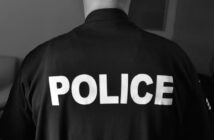Every day across the country, police officers have to make life-or-death decisions in a split second.
But what if you don’t even have that much time?
Officer Chris Caron experienced just this last month in Clovis, N.M.
You see, Officer Caron never saw the gun that shot him.
Running at night after a suspect, his first awareness of the threat he faced was when he got shot.
The event was captured on his body camera and posted by the Clovis Police Department on their Facebook page yesterday.
On Monday, August 29, 2016, at about 11:30 p.m., Officer Caron was on patrol when he stopped Anthony Baca for a minor traffic offense: riding his bicycle down the middle of the street.
Officer Caron made contact with Baca and in what can only be described as a cordial and respectful conversation checked to see if he had any outstanding warrants.
Sure enough, his intuition was right. Baca had a felony warrant for his arrest.
Officer Caron decided to make an arrest and things immediately went downhill. Baca took off running.
Officer Caron gave chase. Simultaneously, he drew his Taser and informed the dispatcher he was in a foot pursuit while still keeping his eye on Baca.
Baca tried to climb a fence and Officer Caron tried to use his Taser. It had no effect.
No, they don’t always work.
Baca continued to run between a car and a wall. Suddenly, Baca quickly rose his right arm. There’s a muzzle flash, a bang and Officer Caron is shot.
I’ve watched the video in real time a number of times. I still never see it coming.
Officer Caron never saw it coming, either. Baca took a blind shot when he was running and managed to shoot Officer Caron in the leg.
Officer Caron drew his weapon, but Baca was gone.
He wisely maintained his position while advising dispatch of “shots fired.”
Despite a search, Baca was not found. Several days later after a media blitz, Baca turned himself in.
This scenario is one police officers encounter every day: chasing bad guys who don’t want to go to jail.
There are a number of ways this could have turned out.
If Officer Caron had been able to draw his firearm, if he had been able to see the gun and he fired, his shot likely would have struck Baca in the back.
If during the foot pursuit, he had seen a furtive movement toward the waistband and thought he saw a gun, he might have fired in self-defense. If the suspect later was found to have been unarmed, there would have been a tremendous public outcry regarding another “senseless” police shooting.
A police officer’s decision to shoot a suspect is often not made with a clear understanding of the facts and under ideal circumstances. Often it is made in the fractions of a second.
In the case of Officer Caron, you could argue he didn’t even have that much time.
Watch the video a few times. Then watch the slow-motion version. Put yourself in Officer Caron’s shoes and see how much time he has to make his life-or-death decision.
Now put yourself in the shoes of the hundreds of police officers who have to make decisions like that every day.
Joe is a retired Anaheim Police Department captain. You can reach him at jvargas@behindthebadgeoc.com.
 Behind the Badge
Behind the Badge


